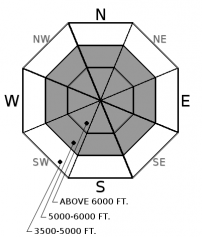| Thursday | Thursday Night | Friday | |
|---|---|---|---|
| Cloud Cover: | Inversion under stratus clouds | Valley inversions | Stratus clouds and flurries |
| Temperatures: | 24 to 29 deg. F. | 18 to 23 deg. F. | 28 to 32 deg. F. |
| Wind Direction: | SW | Southwest | Southwest |
| Wind Speed: | 0 to 10 | 0 to 10 | 0 to 10 |
| Snowfall: | 0 in. | 0 in. | 0 to 1 in. |
| Snow Line: |
Whitefish Range
Flathead Range and Glacier National Park
How to read the forecast
We have seen a string of human triggered persistent slabs, shooting cracks, and audible collapses since last weekend's storm and avalanche cycle ended. Although the danger is gradually easing, the potential for triggering a large and dangerous persistent slab avalanche requires careful snowpack and terrain evaluation.

2. Moderate
?
Above 6500 ft.
2. Moderate
?
5000-6500 ft.
2. Moderate
?
3500-5000 ft.
- 1. Low
- 2. Moderate
- 3. Considerable
- 4. High
- 5. Extreme
-
Type ?
-
Aspect/Elevation ?

-
Likelihood ?CertainVery LikelyLikelyPossible
 Unlikely
Unlikely -
Size ?HistoricVery LargeLargeSmall

Persistent slabs 2 to 4 feet thick over weak facets or faceted crusts remain a slow-to-heal concern on some slopes. These slabs have been most reactive to human triggers in areas with a shallower snowpack, such as the northern Whitefish Range and closer to the Continental Divide. Shooting cracks or collapses are warning signs of unstable snow. These avalanches can be triggered from below connected slopes, highlighted in this video from Monday's avalanche burial. If you find a poor snowpack structure, you can avoid this problem by traveling on lower angle terrain.
With slightly warmer temperatures and more sun in the forecast today, stay alert for the potential for small loose snow avalanches initiating from very steep gullies or faces. Look for sluffing snow or rollerballs to indicate decreasing stability.
If you look through a broader lens at avalanche conditions in the Northwest, stretching from Montana to Southern BC to Idaho and Wyoming, there is a common theme. We all experienced an unusually prolonged drought in early December, which caused a problematic facet layer to form. Since mid-December, we have been in an active loading pattern which culminated during last weekend's storm. Now with clearing skies and gradually improving stability, people are venturing into more aggressive terrain and getting suprised by persistent slab avalanches. There were two avalanche fatalities this week from northern Wyoming (article) and Southwestern Montana (article), and a flurry of near misses across the region. We aren't dealing with a run-of-the-mill storm instability, but rather a buried weak layer that continues to surprise backcountry travelers. Even though the traffic light is no longer blinking red, yellow does not mean hit the gas. It means you should slow down, take your time, and make careful snowpack and terrain assessments.
The Flathead Avalanche Center presents two engaging and free one-hour Avalanche Awareness talks this week. Join us at at Stumptown Snowboards in Whitefish on Wednesday, January 3, from 7 PM - 8 PM ro Stonefly Lounge in Coram on Thursday, January 4, from 7 PM - 8 PM. The class includes general information about avalanche hazard, how to avoid it, and proper equipment for traveling in avalanche terrain. . Contact [email protected] with any questions.
The high pressure ridge broadens across the Western US, making for mostly sunny skies and warming temperatures above the inversion today. Temperatures will be warmer closer to the Continental Divide, rising to near freezing. The ridge starts to flatten and evolve into a small trough on Friday, opening the doors to our next Pacifiic storm. A preliminary glance looks like 5" to 8" of snow through the weekend.
This advisory applies only to backcountry areas outside established ski area boundaries. This advisory describes general avalanche conditions and local variations always occur. This advisory expires at midnight on the posted day unless otherwise noted. The information in this advisory is provided by the USDA Forest Service who is solely responsible for its content.




















